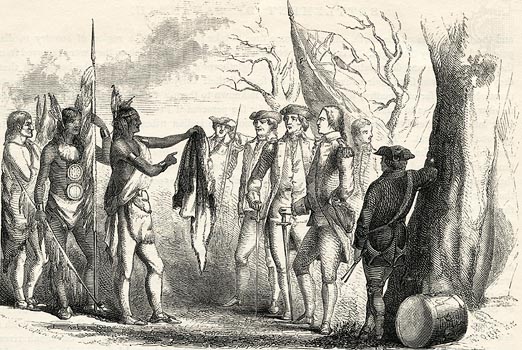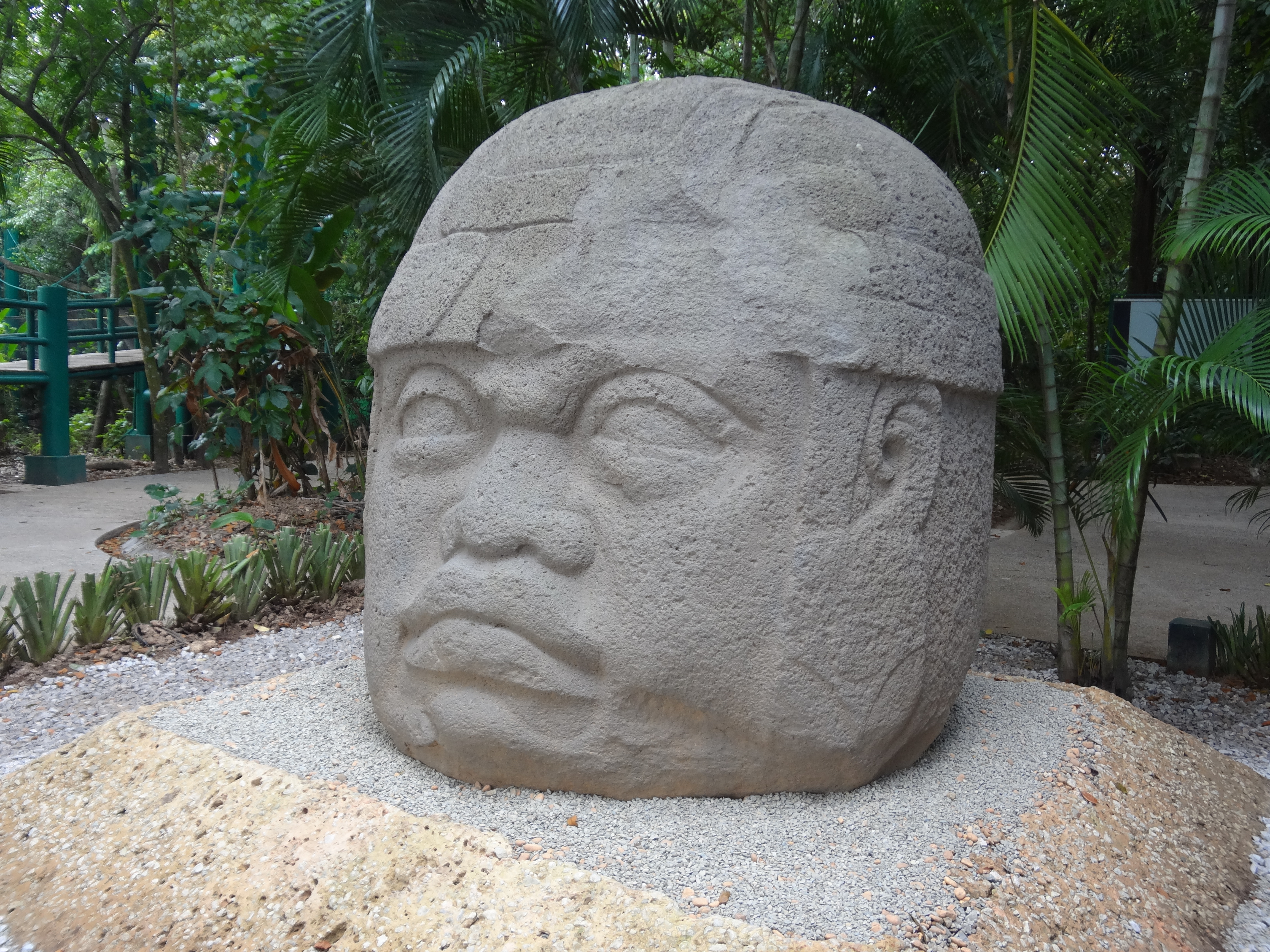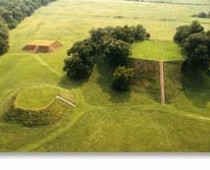Quest for Georgia’s Native Americans | Part 1: Savannah, Georgia
 Around 900 AD, Native Americans in Georgia began constructing a series of towns consisting of enormous earthen pyramids. The largest of these pyramid sites include Ocmulgee and Etowah. It is believed that ancestors of modern Creek Indians were the builders of these sites. Interestingly, evidence including both artifacts and oral histories have always suggested that these Creek Indian tribes were outsiders who migrated into Georgia from someplace else. This series of articles will take the reader on a quest to discover the origins of the people who built these great lost cities of Georgia. We will take a road trip to visit the actual locations where historical events took place and look for clues to help solve the mystery.
Around 900 AD, Native Americans in Georgia began constructing a series of towns consisting of enormous earthen pyramids. The largest of these pyramid sites include Ocmulgee and Etowah. It is believed that ancestors of modern Creek Indians were the builders of these sites. Interestingly, evidence including both artifacts and oral histories have always suggested that these Creek Indian tribes were outsiders who migrated into Georgia from someplace else. This series of articles will take the reader on a quest to discover the origins of the people who built these great lost cities of Georgia. We will take a road trip to visit the actual locations where historical events took place and look for clues to help solve the mystery.
First Stop- Savannah, Georgia
The mystery of the origins of Georgia’s Native American tribe known as the Creek Indians takes us first to beautiful Savannah, Georgia. It was here in 1733 that British General James Oglethorpe first met Tomochichi, the chief of a local Indian tribe called the Yamacraws, when he was founding the new English colony of Georgia. It was Tomochichi who gave the land to General Oglethorpe where Savannah would be located. It was General Oglethorpe who was responsible for laying out the town around public squares. Thus both of these men were responsible for creating the beautiful, picturesque setting for which Savannah is known.
Tomochichi would travel to England with General Oglethorpe and pledge his allegiance to the Crown and thereby secure peace with the English. Upon his return he was held in high esteem among all the local Indian tribes. He was able to use his newfound status to convince some of the more hostile tribes to also forge peace with the English. His efforts culminated in a peace council held in Savannah in 1735 between the chiefs of the once hostile tribes and General Oglethorpe.
The Creek Migration Legend
It was at this council where the first clue in our quest for the origins of Georgia’s Native Americanswas revealed. A chief called Chekilli recounted the history of the Creek Indian tribes. Known today as the Creek Migration Legend, this speech included important details which can be used to help us zero in on the geographical origins of the Creek Indians.
For instance, Chekilli stated:
“At a certain time the Earth opened in the West, where its mouth is. The earth opened and the Cussitaws came out of its mouth, and settled near by. But the earth became angry and ate up their children; therefore, they moved further West. A part of them, however, turned back, and came again to the same place where they had been, and settled there…..Their children, nevertheless, were eaten by the Earth, so that, full of dissatisfaction, they journeyed toward the sunrise.”
From this account we can deduce that the Creek Indians originated in a place west of Georgia that experienced severe earthquakes. But since earthquakes happen many places west of Georgia this clue, alone, does not help us very much. Yet the next clue in Chekilli’s speech does. He stated:
“They lived by this river, and ate of its fishes for two years; but there were low springs there; and it did not please them to remain. They went toward the end of this bloody river, and heard a noise as of thunder. They approached to see whence the noise came. At first they perceived a red smoke, and then a mountain which thundered; and on the mountain was a sound as of singing. They sent to see what this was; and it was a great fire which blazed upward, and made this singing noise.”
This is a very clear reference to a volcano in the act of eruption. Thus we now know we are looking for a place west of Georgia that has both earthquakes and active volcanoes. This helps us narrow our search locations to the western U.S. and Mexico both of which have earthquakes and active volcanoes. Thus, later in our quest we will take a road trip out west and try to figure out where Georgia’s Creek Indians originated.
Now that we know where to look, we must next figure out when to look. Humans have been in North America for at least 12,000 years and volcanoes have been erupting in western North America throughout this entire time. Thus is there any way to determine what time period the Creek Migration Legend refers? According to Creek Indian tradition, the Ocmulgee Mounds site in Macon, Georgia is the place where they “first sat down” after their long migration from the west. Thus if we can find out when they first arrived at Ocmulgee then we can narrow down the time periods in which to look for a volcanic eruption in western North America.
So the next stop on our road trip will be the Ocmulgee Mounds site in Macon, Georgia to see what we can find out about when people first arrived there. But before we leave Savannah, we need to learn about another important person who lived there: Charles C. Jones, Jr. He was elected mayor of Savannah in 1860. But we’re more interested in a book he wrote in 1865 entitled Antiquities of the Southern Indians, Particularly of the Georgia Tribes.
Mr. Jones wrote about a curious discovery he made when the Funeral Mound at Ocmulgee was excavated. He discovered a skull in the lowest parts of the mound (and thus the oldest or earliest burial there) that did not look like the skulls in the upper, or more recent, parts of the mound. This skull had been artificially deformed in a process known as cranial deformation. Jones noted:
“It was vastly older than those of the secondary interments, and had been artificially distorted to such an extent that the cerebellum was quite obliterated, while the front portion of the skull had not only been flattened but irregularly compressed, so as to cause an undue elevation and divergence to the left.”
Who was this strange individual with the flattened ‘cone-head’ skull? Does this represent the leader of the people who built the enormous earthen pyramids? Just one more question we need to answer when we make our road trip to the Ocmulgee Mounds site in Macon.
Yet there’s one final clue about the origins of Georgia’s Creek Indians. Not only did Chekilli give an oral version of his Creek Migration Legend speech but he also presented a written version of the speech to Oglethorpe. The American Gazetteer, published in London in 1762, reported:
“This speech was curiously written in red and black characters, on the skin of a young buffalo, and translated into English, as soon as delivered in the Indian language…The said skin was set in a frame, and hung up in the Georgia Office, in Westminster. It contained the Indians’ grateful acknowledgments for the honors and civilities paid to Tomochichi, etc.”
It’s interesting that this writer used the term “characters” when describing this Native American writing and not “pictures.” It’s known that Native Americans had a pictographic system used to record information but this never evolved into a true form of writing. Yet the use of the term “characters” suggests that the Creek Indians, at least the chiefs and priests, did, in fact, have a written language. This is quite a shocking discovery and contradicts modern scholarly belief about the lack of a true written language among any Native American group before Sequoyah invented the Cherokee syllabary.
To summarize: we now know the Creek Indians came from a place west of Georgia that had both earthquakes and active volcanoes. We also know they had a written language that used red and black characters. Now on to the Ocmulgee Mounds site in Macon, Georgia to see what new clues we can uncover!
Secrets of Savannah
But before we leave Savannah, we must first visit Chippewa Square on Bull Street and see the heroic statue of General James Oglethorpe. This also just so happens to be the square where the “park bench” scene with Tom Hanks in Forrest Gump was filmed. The Six Pence Pub is also located on this square and is a great place to grab a bite to eat. This English pub was also the location used in a scene in the movie Something to Talk About with Julia Roberts.
The historic Savannah Theatre is also located on this square and is still an operational theater hosting plays and musicals nightly. A coffee shop loved by the locals called Gallery Espresso is located on this square and makes a great place to read up on Georgia’s Native Americans. Didn’t bring a book with you? No problem, just visit E. Shaver, Bookseller just one square south (Madison Square) behind the Hilton Hotel. This little independent bookstore is a true gem of Savannah and has plenty of books of local interest and by local authors. Nearby is the Gryphon Tea Room where you can grab a bite to eat and try teas from around the world. Don’t be surprised to see a movie star or two here because I personally saw actress Sandra Bullock eating here while filming her movie Forces of Nature with Ben Affleck. Across the street is Shop SCAD, a little boutique which sells the amazing arts and crafts of students from the Savannah College of Art & Design.
Just a few blocks north of Chippewa Square is Wright Square where the grave of Tomochichi is located. Unfortunately the original funeral mound that once existed in the center of the square was destroyed in 1883 and replaced by a monument to a railroad tycoon. Tomochichi’s grave was the first monument erected in Savannah and was described by Oglethorpe as a “pyramid of stone.” A new Memorial to Tomochichi was erected in the same square in 1899. It consists of a huge granite boulder with a plaque that reads: ” In memory of Tom-o-chi-chi. The mico of the Yamacraws, The Companion of Oglethorpe, and the Friend and Ally of the Colony of Georgia.” The nearby Wright Square Cafe consistently gets rave reviews by locals and tourists alike and is a great place to grab a bite to eat.
A few blocks north of here is the gold-domed City Hall where the current mayor and city council have offices. Although not the location where Charles C. Jones, Jr. served as mayor, City Hall is located on the exact spot where Oglethorpe and the first colonists landed and met Tomochichi. A historical marker in front of the Hyatt next door has all the details. And the best kept secret lies right behind City Hall: an elevator that takes you down to River Street so you can avoid the very steep stairs or ankle-twisting cobblestone ramps. It’s a true god-send for parents with strollers, disabled or elderly persons or anyone who doesn’t want to ruin their trip with a twisted ankle or bad fall! There are plenty of places to eat on this corner or down on River Street.
Eat up because our next road trip takes us three hours west of Savannah to Macon, Georgia! You may want to throw on some Allman Brothers, Otis Redding or Little Richard for the ride because all three were from Macon.



